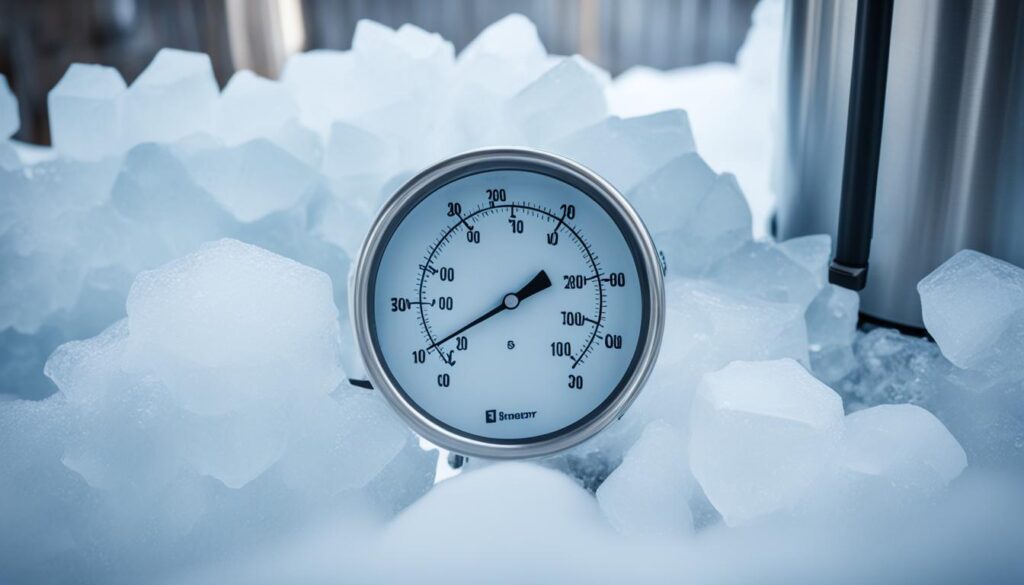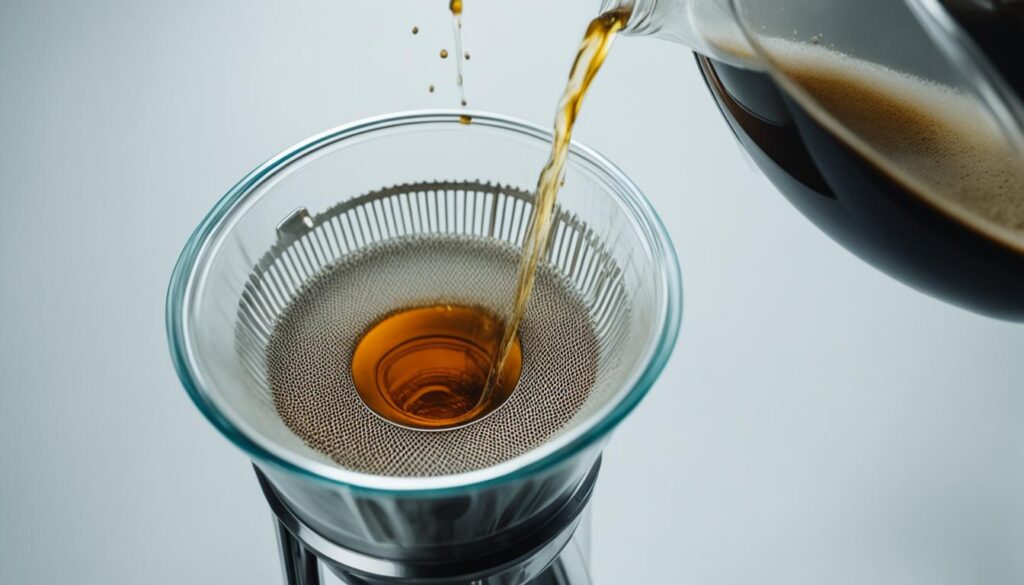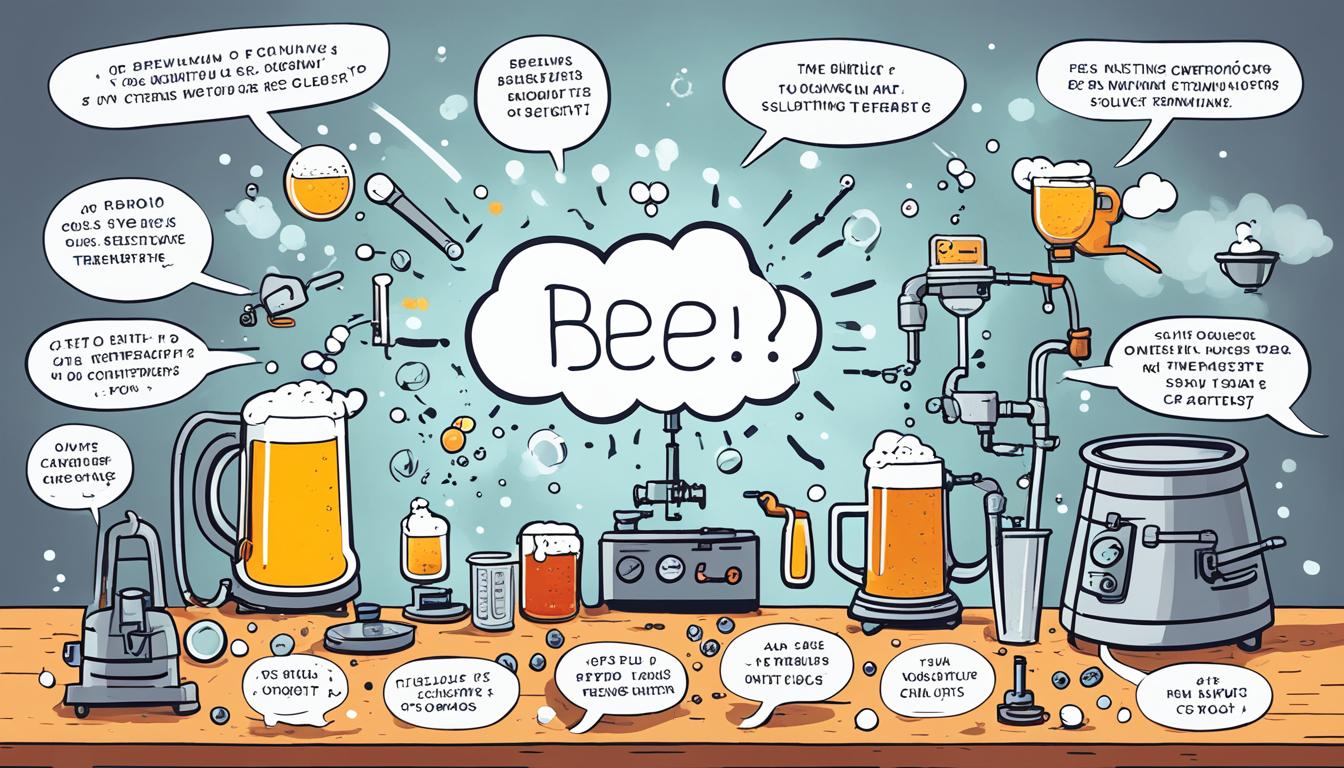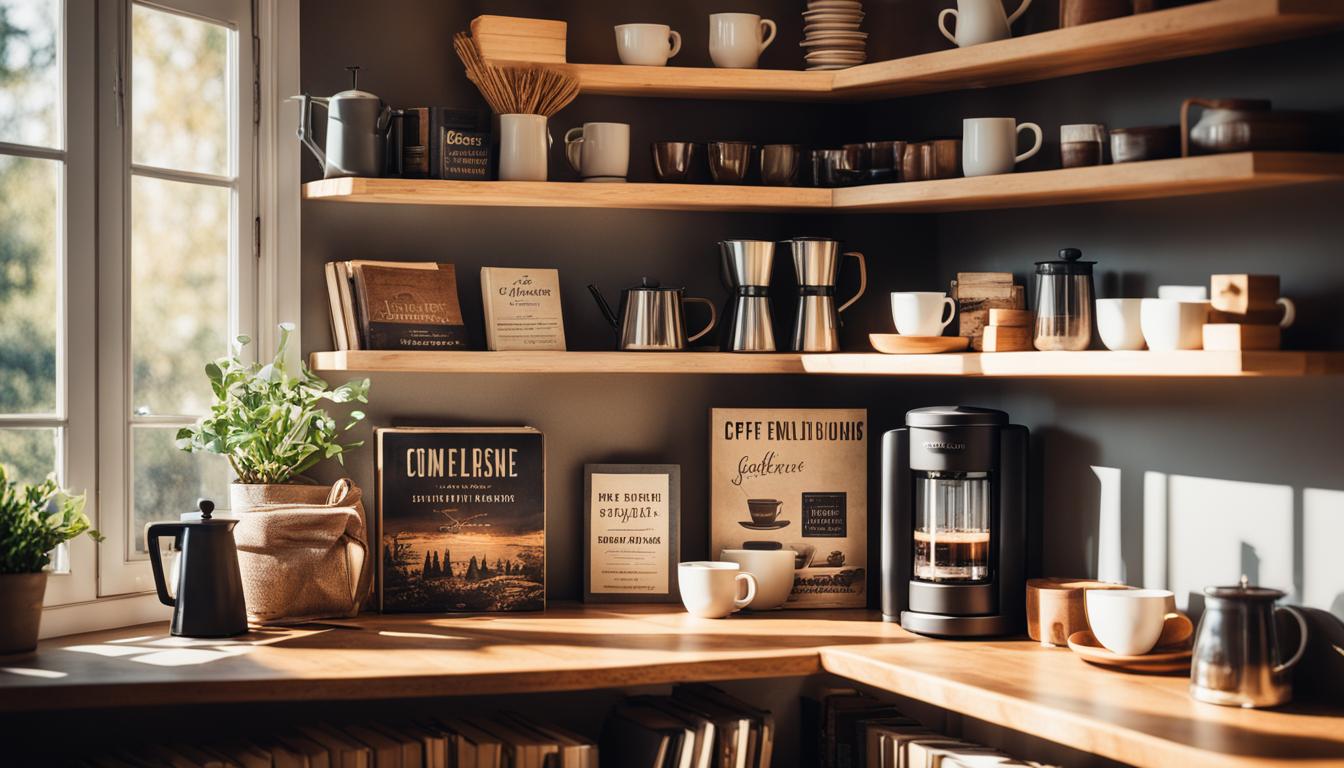Welcome to our guide on troubleshooting common brewing issues! Whether you’re a novice brewer or a seasoned pro, we understand that encountering problems during the brewing process can be frustrating. But fear not, because we’re here to help. In this section, we will explore common brewing issues and provide you with expert tips and solutions to overcome them. By the end of this guide, you’ll be equipped with the knowledge and confidence to troubleshoot and fix any brewing problem that comes your way.
Key Takeaways:
- Identify common brewing issues and understand their causes.
- Learn expert tips and techniques to troubleshoot and solve brewing problems.
- Gain confidence in your brewing skills by overcoming challenges during the brewing process.
- Improve the quality of your beer by addressing off-flavors, carbonation issues, clarity, and sedimentation problems.
- Master the art of trouble-free brewing and consistently produce delicious, high-quality beer.
Understanding Common Issues in Home Brewing
As passionate homebrewers, we understand that brewing beer can sometimes be challenging. In this section, we will delve into some of the most common issues that homebrewers face and provide you with insights on how to solve brewing difficulties and overcome these common challenges.
1. Inconsistent Fermentation
One of the common issues in home brewing is inconsistent fermentation, which can result in off-flavors and a subpar beer. To address this, it’s essential to pay attention to temperature control during fermentation. Maintaining a consistent and appropriate temperature throughout the process is key. If you find inconsistent fermentation, consider using a fermentation chamber or a temperature-controlled fermentation vessel to create a stable environment for your yeast. This will help ensure optimal yeast activity and a successful fermentation.
2. Poor Wort Aeration
Proper wort aeration is crucial for yeast health and fermentation. Inadequate aeration can lead to sluggish fermentation or incomplete attenuation. To solve this brewing difficulty, make sure to aerate your wort thoroughly before pitching the yeast. There are various methods to achieve this, including stirring vigorously, splashing, or using a dedicated wort aeration system.
3. Contamination
Contamination is a frustrating issue that can ruin a batch of beer. To prevent contamination, it is essential to practice good sanitation and proper cleaning of all brewing equipment. Using a sanitizer approved for brewing purposes is vital. Sanitize all equipment, including fermentation vessels, airlocks, and tubing, to ensure a clean brewing environment.
Quote: “Consistency and attention to detail are crucial in home brewing. By addressing these common challenges head-on, you’ll be well on your way to brewing exceptional beers every time.” – Jake Adams, Master Brewer
4. Off-Flavors and Aromas
Off-flavors and undesirable aromas can detract from the overall beer-drinking experience. Understanding and diagnosing the source of these brewing issues is the first step in solving them. Common causes include inadequate yeast pitching rates, improper fermentation temperatures, or contamination. By carefully evaluating each step of the brewing process and identifying potential sources of off-flavors, you can take corrective measures to improve the quality of your beer.
5. Carbonation Challenges
Achieving the perfect level of carbonation is crucial to the enjoyment of your beer. Carbonation issues can range from undercarbonation to excessive foaming. To overcome these challenges, ensure you accurately measure the amount of priming sugar or carbonation drops when bottling. Controlling fermentation temperatures and the amount of headspace in the bottles are also factors to consider.
6. Clarity and Sedimentation
Clear, visually appealing beer is a goal for many homebrewers. However, issues with clarity and excessive sedimentation can occur. Cold crashing and fining agents can help improve clarity by encouraging particles to settle out before bottling. Filtering techniques, such as using a mesh bag or a fine strainer, can also help remove unwanted particles during the transfer process.
Understanding these common issues in home brewing will empower you to troubleshoot and solve brewing difficulties that may arise. By applying the tips and techniques discussed, you will be well-equipped to overcome challenges and consistently produce exceptional homebrews.
Maintaining Proper Fermentation Temperature
Proper fermentation temperature is crucial to the success of your homebrewing process. Temperature variations can lead to a variety of issues that impact the flavor, aroma, and overall quality of your beer. In this section, we’ll discuss the importance of maintaining the right fermentation temperature and provide troubleshooting tips for common temperature-related challenges that homebrewers often face.
During fermentation, yeast convert sugars into alcohol and carbon dioxide, creating the desired flavors and aromas in your beer. However, yeast are sensitive organisms that operate within specific temperature ranges. Fluctuations outside these ranges can result in off-flavors, slow fermentation, or even yeast dormancy.
To troubleshoot temperature-related brewing problems, it’s essential to understand the optimal temperature range for your specific yeast strain. Different yeast strains have different temperature requirements, so it’s crucial to choose the appropriate yeast for your beer style and ferment within its recommended range.
Here are some common temperature-related challenges you might encounter and their potential solutions:
Limited Temperature Control Options
If you don’t have advanced temperature control equipment, it can be challenging to maintain a consistent fermentation temperature. However, there are simple steps you can take to mitigate this issue:
- Place your fermenter in a cool, dark corner of your home, away from direct sunlight and heat sources.
- Use a temperature-controlled fermentation chamber, such as a refrigerator or a DIY insulated box with a thermostat-controlled heat source.
- Opt for yeast strains that are more forgiving of temperature fluctuations, such as Belgian ale yeast or certain lager strains.
Excessive Temperature Swings
Rapid temperature swings during fermentation can stress yeast and produce undesirable flavors. If you’re experiencing significant temperature fluctuations, try the following:
- Wrap your fermenter with insulating material, such as a fermenter jacket or a towel, to help regulate temperature and reduce temperature swings.
- Avoid placing your fermenter near windows or areas with fluctuating temperatures.
- Consider using a submerged or external temperature probe connected to a heating or cooling device to maintain a more stable temperature.
Fermentation in Cold Conditions
Low temperatures can slow down or inhibit yeast activity, leading to incomplete fermentation and a stalled fermentation process. To troubleshoot this issue:
- Warm up your fermenter by moving it to a warmer room or using a heating pad specifically designed for fermentation vessels.
- Ensure that the yeast is healthy and active before pitching it into the wort.
- Consider using a yeast starter or increasing the yeast pitching rate to ensure a robust fermentation process in cold conditions.
By maintaining proper fermentation temperature, you’ll create an ideal environment for yeast to work their magic, resulting in delicious, well-fermented beer. Remember to monitor the temperature regularly during the fermentation process to identify and address any temperature-related issues promptly.

Dealing with Off-Flavors and Aromas
Off-flavors and aromas can significantly impact the taste and enjoyment of your beer. We understand how frustrating it can be to put time and effort into brewing only to be left with undesirable flavors and smells. In this section, we’ll explore common off-flavors and provide practical solutions to help you identify and eliminate them, ensuring that your beer tastes and smells great.
Common Off-Flavors
Before we dive into the solutions, let’s first familiarize ourselves with some of the most common off-flavors you may encounter:
- Skunky: This off-flavor is often a result of light exposure during the brewing process. It can give your beer a distinct, unpleasant odor similar to that of a skunk.
- Diacetyl: Diacetyl creates a buttery or butterscotch flavor in your beer. While some beer styles may have a hint of diacetyl, excessive amounts can detract from the overall taste.
- Acetaldehyde: Acetaldehyde gives your beer a green apple or freshly cut grass aroma. It is usually a sign that the fermentation process was incomplete.
- Phenolic: This off-flavor manifests as a medicinal or band-aid-like taste. It is commonly caused by certain yeast strains or inadequate sanitation practices.
- Yeast Bite: Yeast bite leads to a sharp, harsh, or bitter taste in your beer. It can be a result of using an excessive amount of yeast or fermenting at too high of a temperature.
Solutions to Off-Flavors and Aromas
Now that we’re familiar with some common off-flavors, let’s explore several DIY brewing issue fixes:
- Light Struck Beer: To prevent skunky flavors, avoid exposing your beer to direct sunlight during the brewing and bottling processes. Store your beer in opaque bottles or containers to protect it from UV light.
- Diacetyl Reduction: Ensure proper fermentation and aging by maintaining consistent temperature control and allowing your beer sufficient time to condition. Diacetyl can be reabsorbed by the yeast during the maturation process.
- Complete Fermentation: Ensure that your beer has finished fermenting by using a hydrometer to measure the specific gravity. If the readings remain stable for several consecutive days, fermentation is likely complete, reducing the risk of acetaldehyde off-flavors.
- Sanitation: Thoroughly clean and sanitize all equipment and brewing vessels to minimize the risk of phenolic flavors. Pay close attention to any plastic components that may retain bacteria or mold.
- Proper Yeast Management: Avoid overpitching yeast and fermenting at excessively high temperatures to prevent yeast bite. Follow the recommended yeast pitch rates and fermentation temperature ranges for your beer style.
“The key to solving off-flavors and aromas lies in identifying the specific issues and taking appropriate corrective measures. Remember, brewing is both a science and an art, and with diligent troubleshooting, you’ll be well on your way to producing exceptional beer.”
Now that we’ve covered solutions to off-flavors and aromas, let’s move on to the next section where we’ll address troubleshooting carbonation issues.
Troubleshooting Carbonation Issues
Carbonation is a crucial element that can greatly impact the overall experience of your beer. Achieving the perfect level of carbonation enhances the flavor and mouthfeel, providing that refreshing effervescence we all love. However, it’s not uncommon for brewers to encounter carbonation problems during the brewing process. In this section, we’ll address some common carbonation issues and provide you with DIY brewing issue fixes to ensure your brews are perfectly carbonated.
Diagnosing Carbonation Problems
Before diving into the solutions, it’s essential to diagnose the specific carbonation issue you’re facing. The following are some common problems you may encounter:
- Inadequate carbonation: Your beer lacks the desired level of carbonation, resulting in a flat taste.
- Overcarbonation: Your beer has excessive carbonation, leading to an overly foamy and gushing pour.
- Inconsistent carbonation: Some bottles or kegs have the right carbonation level, while others fall short or have too much carbonation.
Identifying the underlying issue will help you implement the appropriate solutions and achieve consistent carbonation in your brews.
DIY Brewing Issue Fixes
Now that we have a better understanding of the carbonation problems that can arise, let’s explore some DIY brewing issue fixes:
| Potential Carbonation Issue | Solution |
|---|---|
| Inadequate carbonation | Check your priming sugar: Ensure you’ve used the correct amount of priming sugar during the bottling process. Incorrect measurements can result in insufficient carbonation. Use online calculators or reference reliable brewing resources for precise sugar amounts based on your desired carbonation level and batch size. |
| Overcarbonation | Give it time to settle: If your beer is overcarbonated, it may simply need more time to release excess carbon dioxide. Store your bottles or kegs at cooler temperatures (around 40-45°F) to slow down the carbonation process. Regularly check and open a bottle to release some pressure until you achieve the desired carbonation level. |
| Inconsistent carbonation | Proper mixing: Ensure that the priming sugar is evenly distributed throughout the beer before bottling or kegging. Gentle stirring or rolling the keg can help evenly distribute the sugar, eliminating inconsistencies in carbonation levels. |
By applying these DIY brewing issue fixes, you’ll be well-equipped to troubleshoot carbonation problems and achieve the perfect level of carbonation in your brews. Remember, it may take some experimentation and fine-tuning to find the ideal carbonation for your specific beer style, so don’t be afraid to adjust and refine your process along the way.
Resolving Clarity and Sedimentation Problems
Clarity and sedimentation issues can be a common challenge in home brewing, impacting the visual appeal of your beer. Nobody wants to serve a cloudy or sediments-filled brew to their guests. Don’t worry, though! We’re here to guide you through troubleshooting methods that will improve clarity and minimize sedimentation, resulting in visually pleasing homebrews.
One of the most effective ways to achieve clarity in your beer is through proper fining and filtration techniques. Fining agents, such as gelatin or isinglass, can help clarify your beer by binding to suspended particles and facilitating their sedimentation. Filtration systems, such as plate filters or cartridge filters, can also be used to remove particles and improve clarity.

Another important factor in preventing clarity issues is the proper handling of your brewing equipment and ingredients. Always make sure to sanitize your equipment thoroughly to avoid contamination, as bacteria and wild yeast can contribute to haze formation. Additionally, using high-quality malt and hops can help minimize proteins and tannins that may cause haziness.
“Achieving clarity in beer requires attention to detail and proper techniques. By focusing on fining, filtration, and maintaining high-quality ingredients, you’ll be able to produce crystal-clear homebrews that are a delight to the eye.”
In addition to clarity, sedimentation is another concern for homebrewers. Sedimentation refers to the accumulation of solids at the bottom of the bottle or keg, which can affect the mouthfeel and overall quality of the beer. Proper handling after fermentation and careful transfer to serving vessels can help minimize sedimentation. Additionally, giving your beer enough time to settle before packaging can allow particles to naturally settle at the bottom.
Troubleshooting Clarity and Sedimentation Issues: Quick Tips
- Ensure proper fining and filtration techniques are used.
- Handle brewing equipment and ingredients with care and maintain cleanliness.
- Allow sufficient settling time before packaging.
- Consider cold crashing your beer to encourage sedimentation.
- Use fining agents according to their recommended dosage and instructions.
By following these troubleshooting methods and incorporating these tips into your brewing process, you’ll be able to resolve clarity and sedimentation problems, resulting in beautifully clear and visually appealing homebrews that are sure to impress.
| Issue | Cause | Solution |
|---|---|---|
| Cloudy beer | Presence of suspended particles, such as proteins or yeast | Use fining agents or filtration systems to clarify the beer |
| Sedimentation in bottles or kegs | Accumulation of solids during fermentation and transfer | Handle the beer carefully and allow sufficient settling time before packaging |
Conclusion
In conclusion, troubleshooting common brewing issues is an essential skill for every homebrewer. By following the tips and solutions provided in this trouble-free brewing guide, you’ll be well-equipped to overcome any challenges that arise during the brewing process.
With practice and perseverance, you’ll master the art of trouble-free brewing and consistently produce delicious, high-quality beer. Remember to pay close attention to the fermentation temperature, as proper maintenance is crucial for a successful brew. Also, be mindful of off-flavors and aromas, as they can greatly impact the taste and aroma of your beer. Carbonation issues and clarity problems can also be addressed by implementing the troubleshooting techniques discussed in this guide.
By becoming well-versed in the solutions outlined here, you’ll be able to troubleshoot and resolve common brewing difficulties. Say goodbye to brewing mishaps and hello to a trouble-free brewing experience. Cheers to your brewing success!
FAQ
What are some common brewing issues that I may encounter?
Common brewing issues include off-flavors, fermentation temperature fluctuations, carbonation problems, and clarity and sedimentation issues.
How can I troubleshoot off-flavors in my beer?
Off-flavors can be caused by factors such as bacterial contamination, improper fermentation, or poor ingredient quality. To troubleshoot off-flavors, ensure proper sanitation practices, monitor fermentation temperature, and use high-quality ingredients.
What should I do if my fermentation temperature fluctuates?
Fluctuations in fermentation temperature can lead to off-flavors or incomplete fermentation. To troubleshoot temperature issues, monitor and control the temperature using a fermentation chamber, temperature controller, or ice bath.
How can I address carbonation problems?
Carbonation problems can result in under-carbonated or over-carbonated beer. To troubleshoot carbonation issues, check that you have properly primed your beer with the correct amount of priming sugar or adjust the storage temperature and time for bottle conditioning.
What steps can I take to improve clarity and reduce sedimentation?
To improve clarity and reduce sedimentation, use fining agents like gelatin or Irish moss during the last stages of fermentation, minimize agitation when transferring the beer, and ensure proper cold crashing and conditioning before bottling or kegging.




